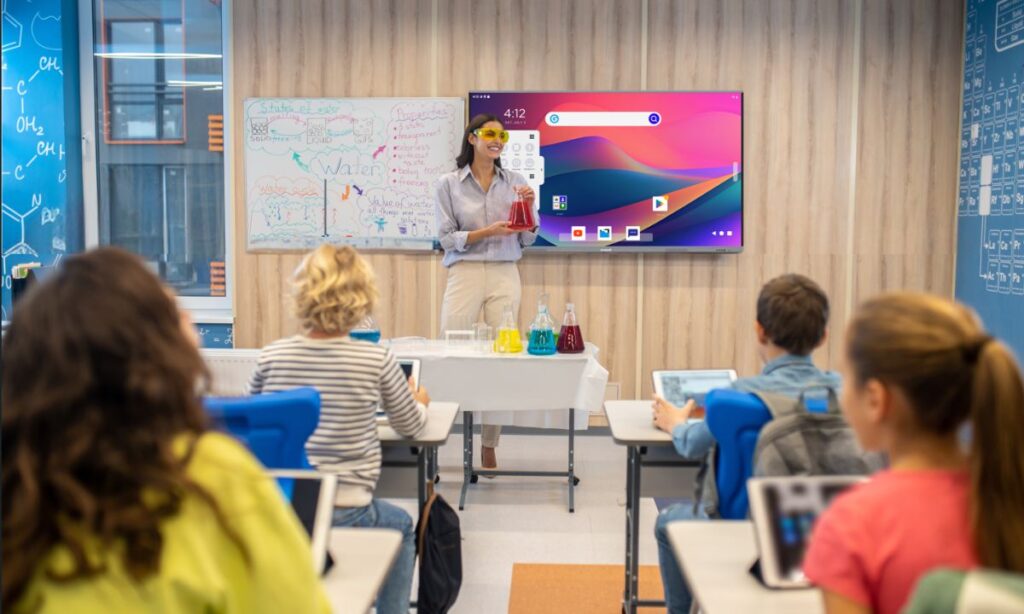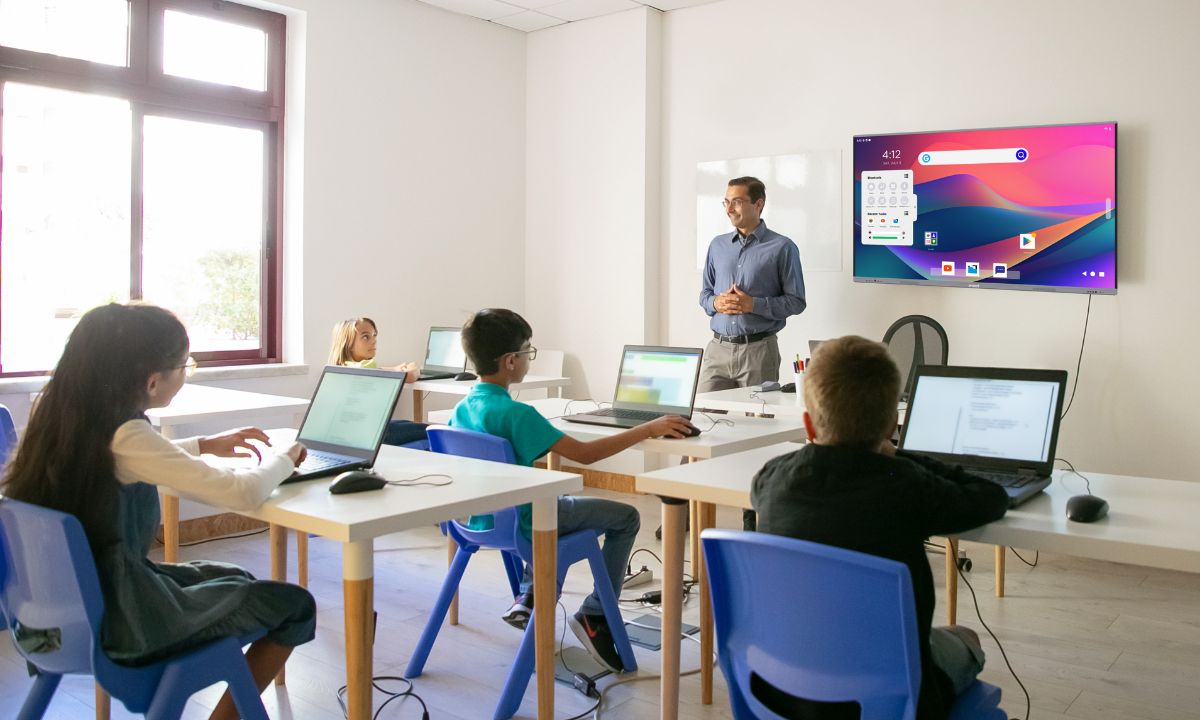What is a Smart Classroom?
A Smart Classroom is a learning space that has been enhanced with educational technology and is designed to improve the teaching and learning experience. It is equipped with a range of interactive edtech tools that allow students to learn, collaborate and innovate in incredible ways, all while supporting the needs of every learner. A standard Smart Classroom usually includes a computer, interactive whiteboard, camera, microphones and many other tools . Smart classrooms allow teachers to adapt their teaching styles to meet the needs of their students. By using a range of technologies and smart classroom management, teachers can support their students’ educational and additional needs, and cater for each child’s individual learning plan.
Components of a Smart Classroom:
- Interactive Flat Panel Displays (IFPDs):
- At the heart of a smart classroom is the Interactive Flat Panel Display. These sleek, touch-sensitive screens replace conventional blackboards and whiteboards, transforming them into dynamic hubs for interactive lessons, multimedia presentations, and collaborative activities.
- Digital Podium:
- The digital podium serves as the command centre for educators, integrating seamlessly with IFPDs. It features a built-in computer, touch interfaces, and connectivity options, empowering teachers to deliver content with fluidity and incorporate digital resources effortlessly.
- Information Kiosks:
- Information kiosks act as information hubs within smart classrooms, providing interactive maps, event schedules, and campus directories. They enhance communication and accessibility, ensuring students have easy access to essential information.
- OPS Mini PC (Open Pluggable Specification):
- OPS Mini PCs adhere to a standardised computing module specification, offering a compact and modular solution for integrating computing power into smart classrooms. These mini PCs support various educational applications and facilitate seamless integration with display systems.
- Wireless Microphone System:
- Wireless microphone systems amplify the teacher’s voice, ensuring clear communication throughout the classroom. This enhances the mobility of educators, allowing them to move freely and engage with students while maintaining a strong and audible presence.
- Document Camera/Visualisers:
- Document cameras, or visualisers, capture real-time images or objects, projecting them onto screens. They facilitate dynamic presentations, hands-on demonstrations, and collaborative discussions, making learning more visual and interactive.
- Speakers:
- High-quality speakers deliver immersive audio experiences in smart classrooms. They are essential for multimedia presentations, video content, and other audio-enhanced lessons, contributing to a rich auditory learning environment.
- Educational Software:
- Educational software encompasses a wide range of applications designed to support teaching and learning. These may include interactive learning platforms, educational games, content creation tools, and adaptive learning systems tailored to individual student needs.

Benefits of Smart Classrooms:
The adoption of smart classrooms brings forth a myriad of benefits for both educators and students. Here are some key advantages:
- Enhanced Engagement:
- Smart classrooms create a more engaging learning experience, leveraging interactive tools and multimedia content to capture students’ attention and maintain their interest throughout lessons.
- Collaborative Learning:
- The interactive nature of smart classrooms encourages collaborative learning. Students can actively participate, share ideas, and work together on projects, fostering a sense of teamwork and cooperation.
- Adaptive Teaching:
- Smart classrooms support adaptive teaching strategies. Educators can tailor lessons to individual learning styles, ensuring that each student receives personalised instruction that caters to their unique needs.
- Efficient Classroom Management:
- With tools like wireless microphones, digital podiums, and educational software, smart classrooms streamline classroom management tasks. Educators can organise digital resources, assess student progress, and manage content seamlessly.
- Global Connectivity:
- Smart classrooms facilitate global connectivity and collaboration. Through virtual exchanges, online projects, and interactive discussions, students can connect with peers worldwide, gaining exposure to diverse perspectives.
- Preparation for Future Careers:
- By integrating advanced technology, smart classrooms prepare students for the digital demands of the future workforce. They become familiar with interactive tools, collaborative platforms, and digital literacy skills that are increasingly crucial in modern workplaces.
- Real-time Feedback:
- Educational software and interactive displays allow for real-time feedback. Educators can gauge student understanding instantly, making adjustments to lessons as needed to address questions or concerns promptly.
- Environmental Impact:
- Smart classrooms contribute to a more sustainable educational environment. Reduced reliance on paper, energy-efficient technology, and the ability to conduct virtual activities minimise the ecological footprint of traditional classrooms.
Difference Between Smart Classroom and Traditional Classroom
| Smart Classroom | Traditional Classroom |
| Central to learning, with interactive whiteboards, tablets, laptops, etc. | Limited technology use, mainly projectors for whiteboards. |
| Active learning, with students engaging, collaborating, and solving problems. | Passive learning, with students receiving information from the teacher. |
| Real-time feedback through quizzes, polls, and interactive activities. | Paper tests and assignments with delayed feedback. |
| Equipped with assistive technologies for diverse learning needs. | Limited accessibility features. |
| Facilitator, guiding students and leveraging technology. | Direct instruction, delivering lectures and managing activities. |
| Encouraged through online platforms, shared documents, and interactive activities. | Mainly happens in small groups or teacher-led discussions. |
| Facilitated through virtual connections with experts and peers worldwide. | Focuses on local contexts and resources. |
| Increased engagement, personalised learning, improved outcomes, 21st-century skills, inclusive learning. | Familiar routines, lower reliance on technology, potentially lower cost. |
| Technology investment, teacher training, digital divide, data privacy concerns. | Limited engagement may not prepare students for the future, challenges with diverse needs. |
Challenges and Considerations:
While the benefits of smart classrooms are evident, their implementation comes with its set of challenges and considerations. These include issues related to initial costs, the need for teacher training, ensuring equitable access to technology, and addressing potential distractions posed by digital devices.
Conclusion:
In conclusion, smart classrooms represent a transformative shift in the educational landscape, embracing technology to create dynamic and interactive learning environments. With a comprehensive array of tools and resources at their disposal, educators can nurture a new generation of learners who are not only well-versed in traditional academic subjects but are also equipped with the digital skills and collaborative mindset essential for success in the 21st century. As we stand at the intersection of technology. Here is the London Challenge case study for effectiveness of Interactive whiteboards in classroom.






[…] Here are some specific examples of how Interactive whiteboard can be used in the smart classroom: […]
[…] Dim the lights, choose the right with Promark’s Smart Boards […]